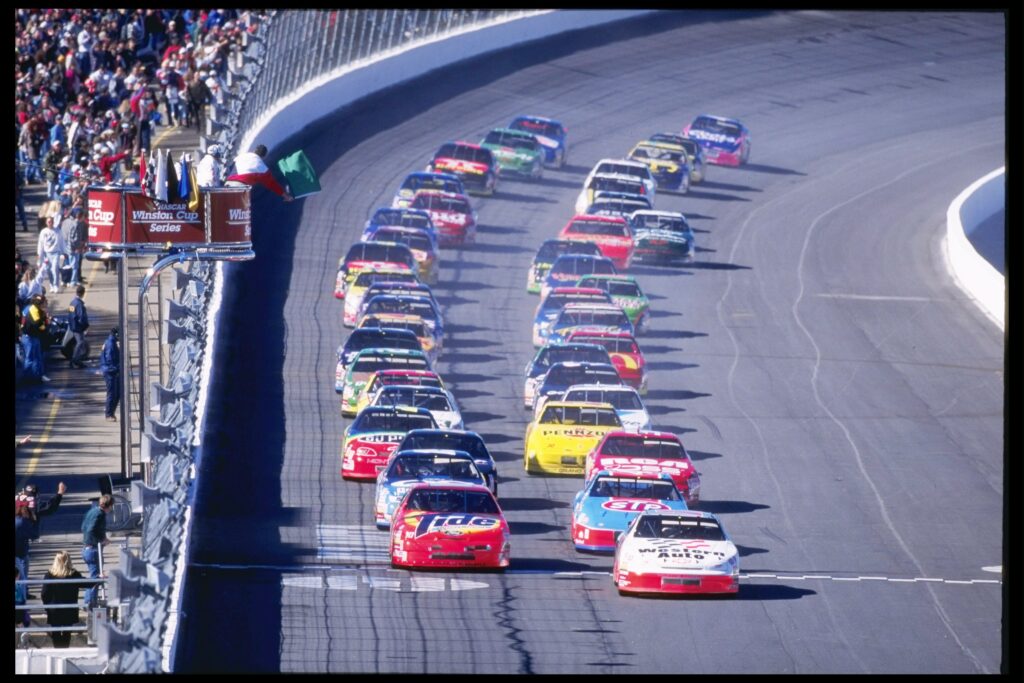All throughout Atlanta’s rich history, it was a fan-favorite (and driver-favorite) track, and that tradition continues through today. Dale Earnhardt Jr. even considers Atlanta race tickets to be the hottest tickets on the circuit. And though since 2022, AMS raced like a superspeedway-style track, that wasn’t always the case. Atlanta Motor Speedway has gone through many different facelifts throughout its history. So, this week, we thought it would be fun to take a look back at all the different layouts AMS has had, from the track’s opening in 1960 to the present day. Here’s how Atlanta Motor Speedway has evolved (and continues to evolve) through the years. Check it out!
The Atlanta Motor Speedway was founded in 1958 by the First Georgia Securities Corporation, with an inaugural NASCAR Cup Series race scheduled to take place in late November of 1959. However, the facility went through several delays, postponing the opening of the track. The newly built Atlanta Motor Speedway officially opened for business in the summer of 1960, with its first NASCAR-sanctioned race taking place in late July of that year. Around that time it was also confirmed that a second annual fall race would be run at the track, this one taking place in late October.
And just like that, the Atlanta Motor Speedway was a permanent fixture on the NASCAR Cup Series schedule. That’s not to say that the facility didn’t face its troubles. There were imperfections and violent bumps all over the racing surface, with USAC spearheading a campaign to resurface the track and add in protective guardrails. In addition to all of the track’s physical problems, it also constantly changed leadership, with track President Alf Lester being challenged by several industry insiders. The track also filed for Chapter 10 bankruptcy in 1971.
Following the track’s 1971 bankruptcy, it received an overall in management. Walter Nix and L. G. DeWitt became track executives and brought the Atlanta International Raceway into the modern era. Under their leadership, they saw AIR host the 1986 Winston, and in 1987, the track started to host the NASCAR Cup Series finale. That same year, Roger Penske offered to purchase the track, but Nix and DeWitt declined.
The initial configuration of the Atlanta International Raceway (later renamed to Atlanta Motor Speedway) was a “true oval,” meaning that it lacked the signature dogleg that it possesses today. The track length was 1.54 miles, with banking in the turns set at 24 degrees. Though the straightaway banking wasn’t specified, track officials stated that they were “banked slightly. In the photograph below, you can see the front stretch of the Atlanta Motor Speedway back in the 1990s.

Beginning in 1987, the Atlanta Motor Speedway started hosting the NASCAR Championship weekend. In fact, to this day the track is the second-longest tenured host of the Cup Series season finale, hosting it for 13 years. For the first 10 years of it hosting the NASCAR finale, the Atlanta Motor Speedway retained its true oval shape. Some classic championship battles took place on this original configuration, including the arguably greatest championship battle in the history of the Cup Series in 1992.
This configuration of the AMS is also where Richard Petty raced his final laps as a driver and Jeff Gordon raced his first. In addition, this version of the track hosted five of Dale Earnhardt’s seven NASCAR Cup Series Championship victories.
Bruton Smith, then owner of Charlotte Motor Speedway and eventual founder of Speedway Motorsports Incorporated, entered negotiations to purchase the Atlanta Motor Speedway in February of 1990. DeWitt initially dispelled any rumors of the track being up for sale, but the transaction became official on October 24th of that year. It was reported that Smith paid over 19 million dollars for the facility.
Under Smith’s ownership, little time was wasted making changes to the track. In 1992, a 2.5 mile infield road course was added, making for the possible transition for the track into a “roval”, similar to what Charlotte Motor Speedway has today. Though NASCAR never used this configuration, Legends Cars did race on the road course.
The first big reconfiguration of the NASCAR portion of the track came with the 1997 repave. These renovations were announced in 1994, with a completion date set in 2000. They included an expansion in seating by 68,000, luxury press boxes, and a dog leg. The latter change essentially transitioned Atlanta Motor Speedway into a quad-oval, a shape it still holds today. Meanwhile, the banking in the turns remained at 24 degrees with a 55ft racing surface. In addition to the dogleg, a quarter-mile oval was added to the front stretch, incorporating the finish line.
Atlanta Motor Speedway kept this configuration for 34 years before being reconfigured into a superspeedway. This configuration also saw some classic NASCAR moments. These moments include Dale Earnhardt’s 75th win in a photo finish against Bobby Labonte, Kevin Harvick’s first win in a photo finish against Jeff Gordon, and Jeff Gordon’s 85th win against protégé Jimmie Johnson.
When it was first announced that Atlanta Motor Speedway was going to be reconfigured into a superspeedway, it was met with skepticism by fans and industry insiders alike. Denny Hamlin, unsurprisingly, was one of the most outspoken critics. Nevertheless, the plan was in motion. In 2022, the track was officially reconfigured into a mile-and-a-half superspeedway-style track. It maintained its dogleg, cookie-cutter shape, but banking in the turns was increased to 28 degrees. In addition to that, the racing surface was reduced from 55ft all around to 40ft in the turns, 42ft on the backstretch, and 52ft on the frontstretch.
Despite initial outcries, this version of the Atlanta Motor Speedway has proven to be more popular over time. The racing is different from that of Daytona and Talladega, with luck playing less of a hand in favor of overall skill. The track surface was also paved to age rapidly. The rapidly aging asphalt, which had been a topic of discussion amongst NASCAR fans on Reddit, meant that handling was and is a major factor during these races.
Under this configuration, the racing product itself seems to be getting better and better with each passing year. We’ve seen a plethora of great finishes under this new design, most notably Daniel Suarez’s win over Kyle Busch and Ryan Blaney last spring.
What are your thoughts, Daily Downforce readers? Which configuration of Atlanta do you like better? Do you love this new version of the track, or are you a traditionalist who prefers the new oval or even the dog-leg intermediate? Let us know! In the meantime, be sure to keep it right here at DailyDownforce.com.
Be sure to follow us on all of our social media platforms, including X, Facebook, and Instagram.
